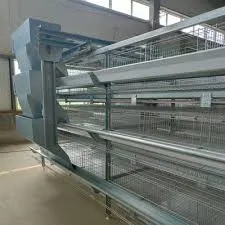Exploring Innovative Designs and Benefits of Modern Poultry Cage Systems for Sustainable Farming
Jul . 21, 2024 02:46 Back to list
Exploring Innovative Designs and Benefits of Modern Poultry Cage Systems for Sustainable Farming
The Evolution and Impact of Poultry Cages in Modern Farming
In the ever-evolving landscape of agricultural practices, the use of poultry cages has become a topic of significant discussion. These structures, designed to house poultry such as chickens, ducks, and quails, play a crucial role in modern farming by streamlining production, enhancing biosecurity, and increasing efficiency. However, they also raise ethical and welfare concerns, prompting a reevaluation of their use in poultry farming.
Poultry cages have been utilized for decades and their designs have evolved dramatically over time. Initially, farmers relied on simple coops or extensive free-range systems, but as the global demand for poultry production increased, the industry sought more efficient methods to raise birds. Caging systems, particularly battery cages, were introduced to maximize space and minimize costs. These cages allow for higher density housing, which leads to increased production rates; however, this method has faced criticism for its implications on animal welfare.
One of the primary benefits of using poultry cages is biosecurity. In a highly controlled environment, the risk of disease transmission among birds is significantly reduced. This factor is especially vital in large-scale operations where an outbreak can lead to devastating economic losses. Cages can help prevent the spread of pathogens by isolating birds from one another and protecting them from external contaminants. Proper management of these systems can lead to healthier flocks and more sustainable production.
Additionally, poultry cages facilitate more efficient feed and water management. With birds housed in a confined space, farmers can closely monitor their dietary intake, ensuring that each bird receives the necessary nutrients for optimal growth and egg production. This precision feeding not only enhances the health and productivity of the birds but also contributes to a more sustainable use of resources.
poultry cage

However, the use of poultry cages has been met with increasing resistance, particularly from animal rights activists and consumers who prioritize ethical treatment of animals. Critics argue that battery cages limit the birds' natural behaviors, such as nesting, foraging, and spreading their wings, leading to physical and psychological distress. This has prompted a growing movement towards more humane alternatives, such as enriched cages and cage-free systems. Enriched cages provide more space, perches, and nesting areas, allowing hens to engage in some of their natural behaviors while still maintaining some of the benefits associated with cage systems.
The rise of consumer awareness regarding animal welfare has catalyzed significant changes in the poultry industry. Many retailers and food producers are responding to public demand for humane treatment by adopting cage-free or free-range systems, despite the challenges these alternatives pose. Cage-free systems, while allowing for more freedom of movement, present their own set of challenges, including increased risk of disease and higher operational costs.
As technological advancements continue to emerge, the poultry industry is at a crossroads. Innovations such as automated monitoring systems, improved ventilation, and alternative housing designs are being explored to enhance both the welfare of the birds and the efficiency of production. The future of poultry farming may well lie in a balanced approach that addresses the dual imperatives of productivity and animal welfare.
In conclusion, the debate over poultry cages encapsulates the broader challenges facing modern agriculture the need for efficiency juxtaposed with ethical considerations. As the industry evolves, it is essential for farmers, consumers, and policymakers to engage in constructive dialogue, seeking solutions that respect both animal welfare and the demands of a growing global population. The path forward will require embracing innovation while considering the moral implications of our food production systems.
-
Automatic Feeding Line System - Anping County Yize Metal Products Co., Ltd.|Pan Feeder Nipple Drinker,Broiler Farming
NewsJul.30,2025
-
Automatic Feeding Line System Pan Feeder Nipple Drinker-Anping County Yize Metal Products Co., Ltd.
NewsJul.30,2025
-
Automatic Feeding Line System-Anping County Yize Metal Products Co., Ltd.|Durable Construction&Easy Maintenance
NewsJul.30,2025
-
Automatic Feeding Line System-Anping County Yize Metal Products Co., Ltd.|Pan Feeder Nipple Drinker&Durable Poultry Farming Solution
NewsJul.30,2025
-
Automatic Feeding Line System Pan Feeder Nipple Drinker|Anping County Yize Metal Products Co., Ltd.
NewsJul.29,2025
-
Automatic Feeding Line System-Pan Feeder Nipple Drinker|Anping County Yize Metal Products Co., Ltd.
NewsJul.29,2025






